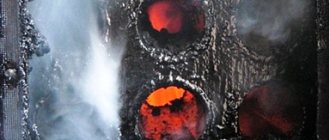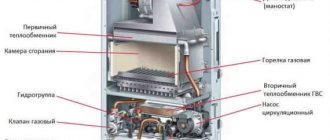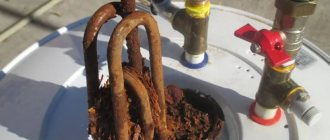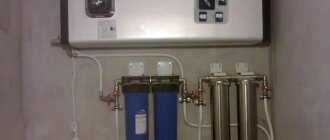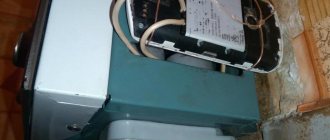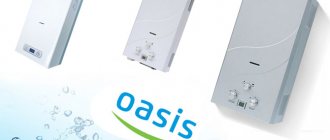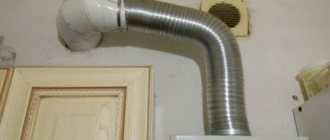The geyser will function without problems for a long time if preventive maintenance is carried out on time. They are most necessary for the heat exchanger (radiator) of the column, which requires regular thorough cleaning. Such prevention is extremely necessary when noticeable deviations from the norm are detected in the behavior of the device.
Preventative maintenance will, of course, be carried out more professionally by a certified specialist, but with a detailed manual, even a first-grader can do it. Below we will tell you how to clean the geyser heat exchanger yourself.
Gas water heater device
To understand how to subsequently clean a gas water heater at home, you first need to find out. what structural elements does it consist of? In appearance, the device resembles a metal box - several pipes (with gas and cold water) are connected to it. Inside there are the following elements:
- heat exchanger;
- igniter;
- main burner.
The principle of operation of the device is as follows: when you open a tap with hot water in a gas water heater, the ignition is automatically triggered (in modern technology, electric and piezo ignition are programmed). This process activates the igniter: the main burner is ignited, which is responsible for heating the cold water located in the heat exchanger. Many gas boilers operate this way, for example, Bosch, Vector and others.
The principle of operation of modern geysers
The design of modern heat exchangers is technically sophisticated. For example, in the Neva Lux gas water heater, the heat exchanger is made in a spiral coil shape. Thus, the water heats up very quickly. All combustion products are removed from the room into ventilation through the chimney pipe.
First signs of pollution
Considering all of the above, we can say that the first sign of contamination of the gas water heater is a drop in the pressure of the water that comes out of the device. The second sign is its slow heating. If this happens, it means cleaning is necessary.
But there are several other signs that indicate that the heating unit is working ineffectively and incorrectly:
- The column does not turn on when the water supply is open. Or it turns off spontaneously during operation. Here it is necessary to exclude a drop in pressure in the water main. The same goes for gas supply.
- Spontaneous shutdown when the column overheats. The reason is a thermal sensor that turns off the system completely. And it works due to the fact that water begins to boil inside the heat exchanger pipes. And this happens for one reason - a small volume of water inside.
Reasons indicating the need to clean the gas water heater
You need to clean the gas water heater if:
- difficulties arise with igniting the main burner, sometimes this is accompanied by a strong bang;
- the heater starts, but does not function for long, the main burner quickly turns off;
- Soot is falling from below, from under the casing;
- the unit operates at maximum power, but the water heats up very little.
If you hear a pop in the combustion chamber, this indicates that a large amount of gas is accumulating in it before ignition. This means that the problem is related to the igniter, which ignites the fuel with a delay. A sign is the fact that the wick flame is yellow, this indicates that the nozzle is clogged.
You just need to clean the igniter. In many columns, the ignition unit can be easily disconnected from the main burner and all debris can be removed from the nozzle.
If the overheating and draft sensors are triggered, it means that a large amount of soot has accumulated between the fins of the heat exchanger. The cross-section of the gas-air path decreases, and the water temperature, on the contrary, increases. In such a situation, you need to clean the radiator of the gas water heater and the walls of the combustion chamber from soot.
The main burner is located under the heat exchanger, and soot primarily forms on its nozzles. That is, the first contamination will lead to another, and as a result, you will need to do double work yourself: remove dirt from the heat exchanger and burner device.
If running water heats up weakly, it means that the flow area of the heat exchanger pipes has decreased, and a large layer of scale has formed on the inner walls.
Option for cleaning the water intake unit
We figured out how to clean the burner of a gas water heater, what to use and how to flush the radiator. The last point in the review is cleaning the water inlet assembly. It contains a strainer that prevents large pieces of rust and other deposits from clogging the pipes. It is imperative to check the membrane tension - if it is insufficient, there will not be sufficient draft from the gas water heater after turning on the water tap.
How to clean the column if the water intake unit is clogged:
- Remove the unit from the device.
- Unscrew the screw part and open the housing.
- Clean the filter under a powerful running stream of water.
- Check the membrane - if there are bulges, the part has served its purpose and needs to be replaced, it would be best to install a silicone product.
- Close the water inlet cover, preferably using screws. This will ensure maximum uniform tension.
You can only clean the jet nozzles yourself - in other situations you will need the help of a professional technician. The plumbing component is not so complicated and allows for “household” interventions. The main thing is to follow the basic rules and follow the established standards of work.
How to remove soot from a heat exchanger
To make the procedure easier, you need to remove this element from the column. To do this, you need to turn off the water and gas, then open the hot water tap, which is located closer to the flow-through heater. Then, using an open-end or gas wrench, you need to loosen the union nut securing the pipe to the water unit and unscrew it a few turns. The entire contents of the heat exchanger must flow out through the mixer; for this it is necessary that it be open.
You can read more about ways to descale boilers in this article.
Before doing this work at home, you need to purchase a universal aerosol solution for loosening boiled threaded joints. WD40 is widely popular; you can find it in any hardware store.
Then, to clean the column, you need to unscrew both union nuts and remove the assembly. Before this, you will need to disassemble other elements of the device that do not allow dismantling the heat exchanger. Their number is individual in each case, it all depends on the specific model of the column and its design.
In some cases, you will have to remove the smoke exhaust diffuser, in others, the ignition group, and in certain cases, the draft or overheating sensor. It may be necessary to disconnect all of these elements.
Heat exchanger contaminated with soot
When dismantling the heat exchanger, cover the burner nozzles with a rag to prevent soot from getting there. When the disassembly process is completed and the unit is removed, cleaning the heat exchanger will not be difficult. Take it to the bath and use a brush and detergents to wash off all the soot from it, and then dry it well.
Then place the assembly back in place and reassemble the heater. In areas where pipes are connected, be sure to replace the O-rings. As a final step, perform a leak test and start the device.
First, the water supply begins to open and the heat exchanger is filled due to the open tap. Then the tap must be closed and the structure inspected for permeability of connections. If everything is normal, then you can open the gas valve and check the column in operating mode.
Classification of methods
To eliminate scale from the device, you can completely disassemble it, you can do without these measures. In the first case, the level of pollution is serious. In the second, only the radiator is cleaned.
There is another way - to clean the igniter, electrode system and water block.
If the situation requires you to disassemble the device, it will not hurt to have an idea of the circuit diagram of its structure.
A typical drawing of such units is as follows:
If the gas water heater is thoroughly clogged, the flame of its burner will turn yellow. This is the main sign of serious blockages.
If the igniter produces a weak flame, local soot removal is required.
How to clean the heat exchanger of a geyser from scale
After removing the heat exchanger, you can perform one more procedure - descaling the gas water heater. To do this, you can use the following tools:
- ready-made composition from the store;
- you can prepare your own solution from citric acid (100 grams of powder per 0.5 liters of water);
- vinegar solution (9%) in a ratio of 1:5.
The sequence of actions will be as follows:
- if you use a store-bought product, clean according to the instructions;
- if you decide to resort to folk remedies, then you need to pour the prepared composition into the heat exchanger using a watering can. You need to wait a while (several hours, but it’s better to leave it to soak overnight). Then you need to drain the contaminated liquid, and rinse the part itself well under running water.
Methods and means of cleaning
The instructions must describe in detail the rules for cleaning the components of the device, deviating from which can be life-threatening. If, during the process of descaling or burning, damage to one of the elements of the device occurs and a gas leak occurs, you must immediately contact the emergency gas service.
Before proceeding with the procedures for cleaning the column, it is necessary to block access to gas and water
If, after weighing all the pros and cons, you have decided to clean the device yourself, we suggest that you familiarize yourself with industrial preparations and folk remedies that will allow you to effectively get rid of contaminants.
In the video below you can see in more detail how to flush a water heater radiator using citric acid:
Before starting work, be sure to turn off the gas and water supplies.
You can clean it with your own hands:
- burner for soot and soot;
- internal parts from dust;
- anti-scale heat exchanger;
- water pipes.
Basic cleaning products:
| Problem | Folk recipe | Industrial product |
| Scale in the heat exchanger | An aqueous solution of citric acid (100 g of substance per 0.5 l of hot water) | Calgon, "Antinscale" |
| Carbon deposits on the heat exchanger | A solution of table vinegar and warm water (1:3) | 7-10% hydrochloric acid solution |
| Dust on internal parts | Warm soap solution | Regular household vacuum cleaner |
Descaling
You can remove scale using chemicals, following the manufacturer's recommendations, as well as folk remedies.
If the second option is chosen, you must adhere to the following procedure:
- disconnect the device from gas and water;
- disconnect the heat exchanger, remove it from the wall, drain the water;
- using a bulb or syringe, pour a cleaning agent (soda or vinegar solution) into the heat exchanger pipes;
- then we immerse the entire part in a deep basin with the same mixture and leave it for several hours.
After the contaminants have been completely removed, the heat exchanger is connected back and the column is started. The water pressure will finally clean the inner surface of the pipes, making them perfectly clean.
The heat exchanger is an important part of the water heating device, which ensures the transfer of heat from the burned gas to water
The heat exchanger can be cleaned without dismantling. To do this, remove the front panel and disconnect the device from the water supply hose. After that, the cleaning solution is poured into the pipes through the inlet. The device is left in this form for 2-3 hours, after which the liquid is drained and everything is returned to its place.
Removing soot and soot
You can clean the surface of parts from soot without disassembling the column in just a few minutes. To do this, you must adhere to the following procedure:
- turn off the gas and remove the front part of the housing;
- wipe the internal parts with a damp cloth or vacuum;
- put the column back together.
From the video below you will learn how to quickly and effectively clean soot from burners:
Cleaning the injectors
If the column begins to burn weakly, most likely the nozzle is clogged. You can find it on the gas manifold near the pressure sensor. For cleaning, use a thin wire or a stiff brush.
After the work is completed, it is necessary to check the column and eliminate the possibility of gas leakage. To do this, lubricate the burner with soapy water and make sure there are no bubbles.
If the nozzles are clogged, the gas begins to burn weaker and the device stops heating water.
Cleaning the water intake unit
In addition to the water heating part, any geyser is equipped with a water intake unit, the main task of which is to prevent large solid particles from entering the heat exchanger. Over time, the mesh filter and membrane, which is responsible for the automatic supply of gas when the water is turned on, become contaminated.
To clean the water inlet, you must:
- remove it from the column body;
- rinse the filter under running cold water;
- inspect the membrane for bends and bulges (if there are defects, the membrane must be replaced with a new one).
After examination and washing, all parts are installed in place, and the water inlet is closed with a lid.
How to clean a gas water heater from soot
The carbon deposits that form on the heat exchanger negatively affect the performance of the heater, and due to clogged nozzles, the water heater may stop working altogether. During preventive maintenance, you need to clean the injectors and remove carbon deposits from the heat exchanger. You can do this this way:
- Wash the heat exchanger with a regular soap solution - initially you should vacuum the radiator and get rid of carbon deposits and dirt. To remove soot, use a soft, long-bristled brush.
- Remove carbon deposits from the burner using a special hook - this way you can thoroughly clean all the holes. After servicing, the gas supply is adjusted.
Homemade instantaneous water heater for small household needs
I will sell this homemade product or make it to order. Message me or leave a comment to discuss details. Good day everyone. This article may be useful for those who are faced with the problem of disconnection or lack of hot water. The technique will also be relevant for summer cottages, where installing purchased water heaters is not always advisable.
Necessary materials
The source of heating the water will be a gas stove. There are 2 options for how to quickly make an instantaneous water heater, but their operating principle is the same. In the first case, you will need a copper tube. In the second option - an old car radiator (it is better to give preference to a copper one, whatever is available). You will also need 2 hoses and 2 clamps.
Stages of manufacturing a water heater
If you use a copper tube as a heating element, then initially it will need to be bent in such a way as to form a spiral. You can make the coil neat and even by wrapping the tube several times around another pipe of the required diameter or something similar, as shown in the photo.
(The picture was taken from the network as an example, since my bending process was not filmed due to the fact that I preferred to make an instantaneous water heater from a car heater radiator). The main thing is that one edge of the pipe is free, otherwise it will not be possible to remove the spiral it will work out. All further steps for making an instantaneous water heater for a copper coil and radiator are the same. You need to take 2 hoses. We connect one of them to a cold water tap, and the other end to the radiator pipe of the stove (or copper tube). The second hose, respectively, to the second pipe. Heated water will flow from it. To prevent leakage, clamp the edges at the junction of the hose with the water heater element with a clamp. In my case, such actions were not required, since the whole village was quite tight. Open the cold water tap, light the fire and place the radiator (or coil) on top of the cooking stove grate.
(no votes yet)
How to protect a gas water heater from scale
The problem of scale formation is due to the fact that salts, which are in the liquid state in water, begin to harden when intensely heated. The suitable temperature regime at which accelerated crystallization occurs is 70-80°.
Accordingly, deposits form in tanks of storage water heaters much faster than in flow-through columns with a less high heating intensity. There are rough spots inside the tank and heat exchanger pipes on which scale deposits more strongly.
In order to avoid the formation of these deposits, a filtration and cleaning system must be used. Water treatment includes several degrees of protection:
- Mesh main coarse filter - mounted on the cold water supply. It must be included in the water heater piping diagram. The mesh retains large pieces of metal, and it also prevents debris from accumulating in the nodes of the column, taps, and relief valve.
- Water filter for water softening - it looks like a plastic flask in which a tube is located, or salt crystals are poured in. As liquids pass through, the chemical composition changes. A filter for a geyser will reduce the amount of scale formed by half. Ion exchange resin cartridges for water softening are considered the most effective and efficient way to protect the heat exchanger. Despite the fact that installing such a filter involves some costs, from an economic point of view it is absolutely justified, since you will increase the service life of the geyser by at least 30%.
- Magnetic filter - this device is based on the magnetohydrodynamic conversion process. The device includes two magnets that form a field. Calcium salts, in the process of passing through the compartment on which the water filter is located, are modified into aragonite. The substance does not remain on metal surfaces, and as a result, scale does not appear. The magnetic filter is mounted on a section of the pipe where there is no scale.
You can learn about filters for boilers and water heaters here
Thus, cleaning the geyser at home is not difficult. And if you carry out the procedure in a timely manner, your heater will work effectively for many years.
Expert advice
Sometimes the cause of the smell may be a poor-quality heating element or anode. If the smell or taste in the water reappears after cleaning, this may be the problem.
To avoid problems with scale, perform maintenance on your boiler once a year.
If you have dirty water from a water supply system, a well, or a borehole, place a filter in front of the boiler entrance and periodically change or clean it.
Do not heat the water below +55 degrees. At a lower temperature, microorganisms will multiply in it, especially the dangerous Legionella.
If your water heater tank is made of stainless steel, paint the welds with enamel. This is the weakest point of such boilers.
Install a back pressure valve. It will bleed water if the pressure in the system is too strong or a water hammer occurs. This way you will protect yourself from surprises.
Work principles
A thermocouple is two welded conductors. One is made of alumel and chromel. The thermocouple has one main function - supplying power to the solenoid valve.
Such a part rarely fails. At the exit from the housing there is a bottleneck equipped with a central conductor. The latter is equipped with high-quality insulation, but even it sometimes gets worn out, causing the speakers to go out.
Another problem is contact failure at the thermocouple welding points. In this case, it is impossible to restore the original characteristics. After all, the current generator passes through the same place. It is recommended to purchase a replacement for the old part.
A solenoid valve is also known as a copper wire coil. Inside this structure there are metal cylinders called a solenoid. There is a mechanical connection between this part and the shut-off valve for gas to enter the burner.
When the thermocouple heats up, a current is generated. It creates a magnetic field when passing through the coil. It is due to this that the solenoid is pulled inward. The solenoid also has a mechanical connection with the valve. Gas flows to the igniter when the valve is moved.
The thermocouple cools down if the gas does not ignite. Because of this, current production stops. The gas supply stops altogether as the solenoid itself returns to its original position.
This is how you can ensure safe operation of devices under various conditions. This is also due to the fact that problems can arise due to a simple blow of wind if the systems are not equipped with protective mechanisms.
A bimetallic plate is how a thermal fuse can be described. The plate begins to sag when the temperature where the part is installed reaches 90 degrees.
The solenoid power supply circuit is then broken. The thermal fuse is connected to the general circuit using special terminals.
It often breaks due to the fact that the design is complex and has a lot of features.
Reasons for extinction after ignition
If the gas water heater goes out or functions unstably, it is necessary to establish the cause of the problem. For these purposes, you need to find out what causes malfunctions in the functioning of the device. Often the device does not turn on due to:
- turning on an indicator that detects a gas leak;
- difficulties with the chimney;
- valve failure;
- wick clogging;
- main burner attenuation;
- too much ventilation;
- thermocouple opening;
- breakdown of the automatic system.
Important! If the column smokes, turns off, or does not light up at all, you can try to solve the problem yourself. However, it is best to call a specialist in such a situation.
Flame ionization sensor failure
When the device turns on and starts to go out, the ionization indicator is 70% at fault. This component is regularly in contact with fire. The ions produced during combustion are attracted to the sensor and produce a current. When there are enough ions, the device will work. When there are not enough of them, the column turns off.
- the wick goes out after a few seconds after ignition;
- during restart, the column operates longer;
- You should turn on the device several times and it will function normally;
- difficulties arise only after a long break.
Important! It is necessary to inspect the wiring running from the part to the board. For these purposes, contacts are checked
Next, the fixing screws are unscrewed and the heating electrode is placed in the hottest place of the fire.
This technique extends the service life of the indicator by years. When everything is normal with the contacts and connections, the element needs to be replaced.
Wear of the water unit membrane
The effective operation of the device will depend on the serviceability of each component and mechanism. The membrane in such a heater is one of the most important components, but wear occurs over time.
A flexible membrane will be located at the base of the assembly and respond to changes in system pressure. When the mixer opens, the rubber element will bend under pressure and push out the stem. It will turn on the gas valve, causing fuel to flow into the burner.
Important! With intensive use of the device, the membrane will wear out. The rubber will stretch, become clogged and damaged.
As a result, fuel will not flow into the burner: the device does not start or lights up, but immediately goes out.
- Pressure force of gas and water. When the tap opens, you need to calculate how many liters will be consumed per minute. Within normal limits it will be 2-3 liters. The gas supply can be determined visually by looking at the fire.
- Fire position. In devices with wick ignition, the flame burns from the edge and has a height of at least 30-50 mm. If not, then check the jets for clogging. Once the cleaning is complete, you need to look at the fire again. When the situation has not changed, the problem is in the diaphragm.
- Ignition speakers should click when the button is pressed. This means the diaphragm is working. When there are no sounds, the part is probably broken.
- In a number of models, a rod that controls the functioning of the control unit helps to identify a breakdown. The protective cover is removed and the water opens. When the rod is immobilized, the diaphragm needs to be replaced.
When a breakdown is found, you need to choose the right replacement part.
The wick is clogged with dust
In products with an igniter, such an element often becomes clogged. The fire will become weak and a yellowish tint will appear. However, a change in the color of the fire also indicates a lack of air in the gas-air mixture.
The result is that the column either does not ignite the burner at all, or will perform its functions when a large volume of fuel arrives. In the latter situation, a certain click is felt. To clean the element, you will need 2 screwdrivers and an adjustable wrench.
- The case is removed - the adjustment handles are pulled out, the bolts in the corners from the bottom are unscrewed, the cover is lifted and removed.
- The traction sensor tube and the one that draws in fuel are unscrewed.
- The screws are removed and the structure is disassembled.
- The nozzle is cleaned, the tee is blown out, and assembled.
Clogging occurs in the draft indicator, which is why the igniter begins to smoke. When dust and dirt are removed, the igniter lights up with a stable blue flame.
Important! When the column is cleaned, the device is somewhat noisy. The sound will be produced by air being sucked through the cracks in the wick guide housing
It is possible to get rid of the noise by tightening the wick screws a little.

